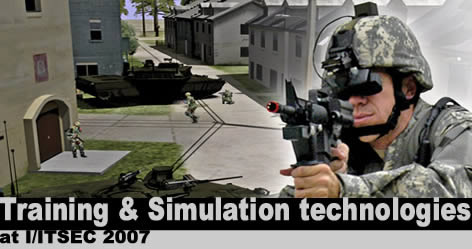Defense Update’s covers some of the latest trends and technologies at the Interservice, Interservice/Industry Training, Simulation & Education Conference (I/ITSEC) exhibition.
Parallel to the development of defense technology, the military profession has become more complex. Besides mastering combat skills, soldiers must be qualified as computer operators, capable to rapidly learn and absorb complex new systems, such as new weapon, protective equipment, versatile radios, cameras, lasers, precision-guided weapons and targeting systems, remote controlled systems and complex command and control networks. Soldiers must be absolutely proficient with these systems, as even the smallest mistake could become devastating, making the difference between victory and defeat.

Modern simulation and training systems are being integrated into the platforms and weapon systems, becoming part of routine operations and sharpening skills and performance, far beyond basic training, which still follows traditional guidelines. Such techniques were optimized for operators using synthetic environment for operation. There are many examples for such special trade applications, including signal and image intelligence analysts, mission payload operators, air defense specialists, air controllers, operators of unmanned aerial, ground or underwater vehicles, etc. Such ‘on the job’ training is embedded in their routine missions and integrated into operational consoles, providing fresh trainees and even seasoned operators with rapid, yet gradual introduction, to more complex tasks, viewed within their operational working environment. Warfighters and support personnel operating under active combat conditions, especially those engaging the enemy with direct fire, must rely on a ‘realistic combat presentation’ training environment, recreating terrain, friendly forces, simulated weapons and systems, enabling trainees to practice their individual, team and collective skills in realistic simulated combat drills.
Limited by existing graphical engines and displays, basic simulators used sofar have supported specific tasks that could adequately and realistically represent real situations with limited details, such as aerial engagements. Examples for such applications were emergency procedures and weapon systems trainers for pilots, communications systems trainers, and tank gunnery simulators. More challenging requirements were met by much more complex flight simulators that could be afforded only by few air forces, to sharpen their fighter pilot’s skills.
 To provide such capabilities, the military has recently begun using gaming technology with the idea that today’s soldiers are more apt to learn from and use the technologies driving today’s XBox and Playstation games. The advancement of games and availability of low-cost PC/graphics processors have evolved to the point of near parity with high-end imaging graphics systems used in high-end simulators, providing the armed forces with viable, effective and exciting video games-based training techniques, used for recruitment and training of specialist warfighters. Different goals and technical challenges are met by current simulators, developed for convoy-infantry trainers, designed specifically to instruct mounted and dismounted infantry fighting in asymmetric, mostly urban warfare. The new training objectives were beyond the capabilities offered by the closed architecture of existing systems. Furthermore, trainees are required to train on realistic urban models, involving detailed geographic representation of the area, where pathfinding and urban navigation can be drilled. Implementing realistic human behavior during riot control, as well as hostile individuals, in addition to correct representation of enemy tactics, techniques and procedures, is becoming top priority in modern asymmetric counter-insurgency operations.
To provide such capabilities, the military has recently begun using gaming technology with the idea that today’s soldiers are more apt to learn from and use the technologies driving today’s XBox and Playstation games. The advancement of games and availability of low-cost PC/graphics processors have evolved to the point of near parity with high-end imaging graphics systems used in high-end simulators, providing the armed forces with viable, effective and exciting video games-based training techniques, used for recruitment and training of specialist warfighters. Different goals and technical challenges are met by current simulators, developed for convoy-infantry trainers, designed specifically to instruct mounted and dismounted infantry fighting in asymmetric, mostly urban warfare. The new training objectives were beyond the capabilities offered by the closed architecture of existing systems. Furthermore, trainees are required to train on realistic urban models, involving detailed geographic representation of the area, where pathfinding and urban navigation can be drilled. Implementing realistic human behavior during riot control, as well as hostile individuals, in addition to correct representation of enemy tactics, techniques and procedures, is becoming top priority in modern asymmetric counter-insurgency operations.
To provide such capabilities, the military has recently begun using gaming technology with the idea that today’s soldiers are more apt to learn from and use the technologies driving today’s XBox and Playstation games. The advancement of games and availability of low-cost PC/graphics processors have evolved to the point of near parity with high-end imaging graphics systems used in high-end simulators, providing the armed forces with viable, effective and exciting video games-based training techniques, used for recruitment and training of specialist warfighters. Different goals and technical challenges are met by current simulators, developed for convoy-infantry trainers, designed specifically to instruct mounted and dismounted infantry fighting in asymmetric, mostly urban warfare. The new training objectives were beyond the capabilities offered by the closed architecture of existing systems. Furthermore, trainees are required to train on realistic urban models, involving detailed geographic representation of the area, where pathfinding and urban navigation can be drilled. Implementing realistic human behavior during riot control, as well as hostile individuals, in addition to correct representation of enemy tactics, techniques and procedures, is becoming top priority in modern asymmetric counter-insurgency operations.
Other topics covered in this review:
- Simulation & Training technologies at I/ITSEC 2007
- Populating the Virtual Worlds
- Training and Simulation for the First Responders
- Practicing Air/Ground Missions

















